The Game: You must choose wisely from a field of candidates to captain your merchant battleship (as well as picking the ship, which can be upgraded at any port), and survive a series of trading adventures along a route that runs from Earth’s sun to Alpha Centauri. In the long empty stretches of space between Pluto’s orbit and Alpha Centauri, there are no resupply/repair outposts – and there are plenty of attacking pirates. Sample passing comets to mine a rare element that will improve the aim of your weapons…and watch out for the Borg. Planetside, you can buy and sell your goods, upgrade your ship, recruit additional crew members, or visit the casino in an effort to increase your funds. Your captain ages as the game progresses (long space hauls still take a while in this universe despite warp drive), and will eventually die – so don’t let yourself run out of crewmembers. (Earl Green & Robert Heyman, 1990)
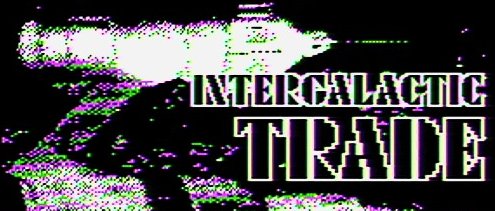
Memories: I recently stumbled across the 5 1/4″ floppy containing Intergalactic Trade: Mark II while doing an entire Saturday of Apple II game screen stills, and I was floored. I had completely forgoten about this game, or how far we’d gotten into the process of programming it in our senior year of high school.
And nowhere in my wildest dreams did I imagine that it was as much fun as it is.

Borrowing its basic structure from Taipan!, Intergalactic Trade: Mark II incorporated Star Trek terminology (warp speed, phasers, etc., as well as one-in-a-million surprise attacks by the Borg), Jump Cut City placenames (which makes sense as we were still enamoured of the idea of producing our own little TV show at that time), very scratchy screen stills from Blake’s 7 for the intro and instruction screens, and even a few elements of Dungeons & Dragons and Ultima IV for good measure. In short, you can easily tell what we were watching and playing at the time we came up with this game.
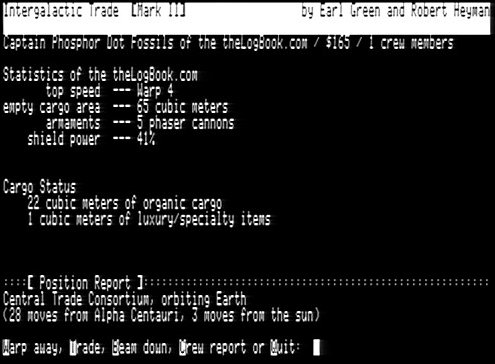
In a somewhat more modernized setting than Taipan, we reasoned that there would be businesses set up at every port to upgrade shields and weapons. And in an admittedly Star Trek-inspired move, combat situations can be solved by negotiation…every once in a while. Your ability to talk your way out of a fight is influenced heavily by the randomly-generated statistics of your captain character; his age, his status (which can range from “hated” to “unknown” to “legendary”) and his charisma all come into play there. If beaten, an enemy ship’s crew may mutiny and offer your their services (and their captain’s cargo) to stay alive; showing mercy to too few enemies will, in an Ultima-esque fashion, start to erode your captain’s reputation.
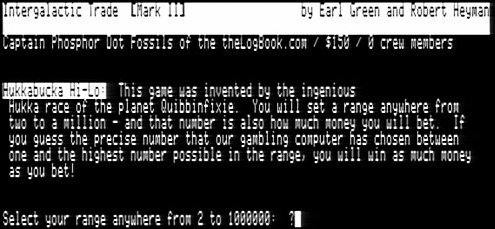
In eleven years, I’d completely forgotten that I had worked on this game in my late teens. I actually find it rather addictive now – yes, it is all text and statistics, and there are still some rough edges that I may go back and try to fix up later. Or who knows? I may try to port this into something more modern – perhaps even a simple web-based game. I’m quite happy with Intergalactic Trade: Mark II (though I don’t remember what on earth happened to Mark I).

I went through the BASIC code and found that the casino odds were heavily weighted in favor of the house; not only a realistic touch, but, like Wil Wright and Richard Garriott, I was dead guilty of working my own beliefs and worldview into the game. Gambling was no way to advance yourself in the universe – indeed, spending too much time gambling also cost you points on your reputation.
Wow. My very own Phosphor Dot Fossil. Too darn cool.
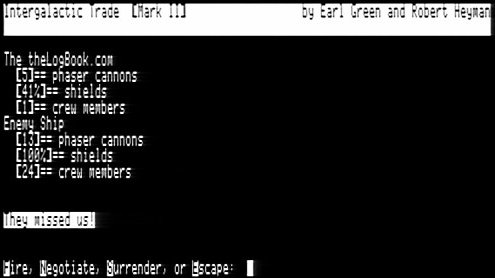
This game is still a work in progress and I’m working on making what there is of the game available as a disk image; keep checking back to this page. If there’s enough interest, I may do a limited run of actual floppies with accompanying documentation, though before going there, I’d very much like to finish the game first. – EG
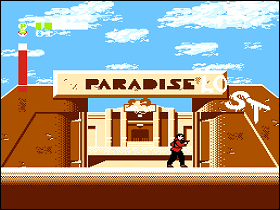 The Game: Sybok, a charismatic Vulcan cult leader, has tried to disrupt the peace process on the neutral planet Nimbus III. Players take control of one Enterprise crewman at a time to: retrieve the Nimbus III hostages (Sulu), save Kirk and Spock from a cell aboard the Enterprise (Scotty), pilot the Enterprise through asteroids and attacking Klingons (Sulu again?), and finally make a mad dash into the heart of the lair of the “god creature” (Kirk). Running out of life energy aborts the mission; fortunately, Dr. McCoy is standing by at all times and the mission can start from scratch. (Bandai, 1989 – unreleased)
The Game: Sybok, a charismatic Vulcan cult leader, has tried to disrupt the peace process on the neutral planet Nimbus III. Players take control of one Enterprise crewman at a time to: retrieve the Nimbus III hostages (Sulu), save Kirk and Spock from a cell aboard the Enterprise (Scotty), pilot the Enterprise through asteroids and attacking Klingons (Sulu again?), and finally make a mad dash into the heart of the lair of the “god creature” (Kirk). Running out of life energy aborts the mission; fortunately, Dr. McCoy is standing by at all times and the mission can start from scratch. (Bandai, 1989 – unreleased)
 The Game: Players slide into the cockpit of Defender once again, defending the power generators on the surface of a human space colony from intruding aliens. As usual, the Defender is a versatile, fast-moving attack ship, but the aliens have an advantage in sheer numbers. Vaporizer bombs can clear the screen of attackers, but they’re in short supply. Eliminating all invaders clears the level and starts anew; running out of Defender craft means the aliens win. (Ensign Software, 1989)
The Game: Players slide into the cockpit of Defender once again, defending the power generators on the surface of a human space colony from intruding aliens. As usual, the Defender is a versatile, fast-moving attack ship, but the aliens have an advantage in sheer numbers. Vaporizer bombs can clear the screen of attackers, but they’re in short supply. Eliminating all invaders clears the level and starts anew; running out of Defender craft means the aliens win. (Ensign Software, 1989) The Game: Captain Picard places Commander Riker – that’s you, by the way – in charge of the Enterprise, which is currently on a mission to find out who is launching terrorist attacks on mining stations in the Aquila solar system. Riker can use the Enterprise’s computer to analyze objects and ships, or to look up Federation data files on the various people involved in the growing conflict. And of course, he can call upon the knowledge and experience of his crewmates for advice, or bring them along as he beams down to the various locales on each planet or asteroid in the game. One thing not at Riker’s disposal is time: the attacks continue, and whoever is mounting the attacks is getting bolder with each attempt. And someone in the Aquila system knows more than they’re telling. (Simon & Schuster Interactive, 1989)
The Game: Captain Picard places Commander Riker – that’s you, by the way – in charge of the Enterprise, which is currently on a mission to find out who is launching terrorist attacks on mining stations in the Aquila solar system. Riker can use the Enterprise’s computer to analyze objects and ships, or to look up Federation data files on the various people involved in the growing conflict. And of course, he can call upon the knowledge and experience of his crewmates for advice, or bring them along as he beams down to the various locales on each planet or asteroid in the game. One thing not at Riker’s disposal is time: the attacks continue, and whoever is mounting the attacks is getting bolder with each attempt. And someone in the Aquila system knows more than they’re telling. (Simon & Schuster Interactive, 1989) The Game: As intrepid plumber (and explorer) Mario, players have to jump through new environments and enemies to help Mario rescue Daisy. Egyptian pyramids guarded by fire-breathing Sphinxes, seaside platforms invaded by space aliens, and the usual Goombas and Koopas await Mario as he tries to reach the end of each level. As always, there are mushrooms, stars and fire flowers to help Mario power up, and helpful hidden chambers full of coins. (Nintendo, 1989)
The Game: As intrepid plumber (and explorer) Mario, players have to jump through new environments and enemies to help Mario rescue Daisy. Egyptian pyramids guarded by fire-breathing Sphinxes, seaside platforms invaded by space aliens, and the usual Goombas and Koopas await Mario as he tries to reach the end of each level. As always, there are mushrooms, stars and fire flowers to help Mario power up, and helpful hidden chambers full of coins. (Nintendo, 1989) The Game: Cavernous rooms are loaded with gold, just ripe for the picking. But before you celebrate hitting the mother lode, look again – there are other gold-diggers homing in on the treasure. What do you have that they don’t? A drill gun that can blast a hole in the floors, into which your opponents will jump blindly. Eventually, the holes will reseal themselves, and that process will swallow your enemies (and you, if you happen to be clumsy enough to wander into the hole yourself). Grabbing all of the gold will reveal a passage to the next level of the game. (Bandai, 1989)
The Game: Cavernous rooms are loaded with gold, just ripe for the picking. But before you celebrate hitting the mother lode, look again – there are other gold-diggers homing in on the treasure. What do you have that they don’t? A drill gun that can blast a hole in the floors, into which your opponents will jump blindly. Eventually, the holes will reseal themselves, and that process will swallow your enemies (and you, if you happen to be clumsy enough to wander into the hole yourself). Grabbing all of the gold will reveal a passage to the next level of the game. (Bandai, 1989) The Game: Chef Peter Pepper is back, and boy, is he kawaii. As in the original Burgertime, the chef has to climb ladders and cross levels – while being chased by deadly ingredients – all in the pursuit of building the perfect giant burger. If he drops the burger on them, the chef’s opponents can become part of the meal. He can also spray them with pepper, as in the original game, or grab bonus weapons (such as a frying pan with which to brain them) from the sides of the screen when they intermittently appear. If enemies are on a bun, patty, etc. when it’s dropped, they’re temporarily taken out of play. Players advance a level by completing construction of all of the burgers. (Data East, 1988?)
The Game: Chef Peter Pepper is back, and boy, is he kawaii. As in the original Burgertime, the chef has to climb ladders and cross levels – while being chased by deadly ingredients – all in the pursuit of building the perfect giant burger. If he drops the burger on them, the chef’s opponents can become part of the meal. He can also spray them with pepper, as in the original game, or grab bonus weapons (such as a frying pan with which to brain them) from the sides of the screen when they intermittently appear. If enemies are on a bun, patty, etc. when it’s dropped, they’re temporarily taken out of play. Players advance a level by completing construction of all of the burgers. (Data East, 1988?) The Game: You’re in charge of a getaway car loaded with crafty criminals. Your job is to sneak around the maze, avoid a bunch of cranky cops who are hot on your trail, and grab all the dough – and, of course, to escape so you can steal again another day. But the cops can trap you with a series of doors that can prevent you from getting away… (Data East, 1990)
The Game: You’re in charge of a getaway car loaded with crafty criminals. Your job is to sneak around the maze, avoid a bunch of cranky cops who are hot on your trail, and grab all the dough – and, of course, to escape so you can steal again another day. But the cops can trap you with a series of doors that can prevent you from getting away… (Data East, 1990)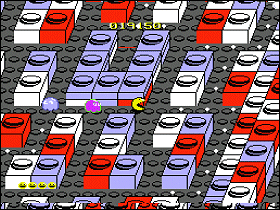 The Game: As a round yellow creature consisting of a mouth and nothing else, you maneuver around relatively simple mazes, gobbling small dots and evading five colorful monsters who can eat you on contact. In four corners of the screen, larger dots enable you to turn the tables and eat the monsters for a brief period. Periodically, assorted items appear near the center of the maze, and you can consume these for additional points as well. The monsters, once eaten, return to their home base in ghost form and return to chase you anew. If you clear the maze of dots, you advance to a new maze and the game starts again, but just a little bit faster… (Tengen, 1990)
The Game: As a round yellow creature consisting of a mouth and nothing else, you maneuver around relatively simple mazes, gobbling small dots and evading five colorful monsters who can eat you on contact. In four corners of the screen, larger dots enable you to turn the tables and eat the monsters for a brief period. Periodically, assorted items appear near the center of the maze, and you can consume these for additional points as well. The monsters, once eaten, return to their home base in ghost form and return to chase you anew. If you clear the maze of dots, you advance to a new maze and the game starts again, but just a little bit faster… (Tengen, 1990) The Game: You are a marker, trying to claim as much of the playing field as you can by enclosing areas of it. Drawing your boundaries faster is safer, but yields fewer points. A slower draw, which leaves you vulnerable to attack from the Qix and the Sparx, gives you many more points upon the completion of an enclosed area. If the ever-shifting Qix touches your marker or an uncompleted boundary you are drawing, you lose a “life” and start again. And the Sparx, which travel only along the edges of the playing field and along the boundaries of areas of the screen you’ve already enclosed, can destroy you by touching your marker. And if you linger too long, a fuse will begin burning at the beginning of your unfinished boundary, and will eventually catch up with you. (Nintendo/Taito, 1990)
The Game: You are a marker, trying to claim as much of the playing field as you can by enclosing areas of it. Drawing your boundaries faster is safer, but yields fewer points. A slower draw, which leaves you vulnerable to attack from the Qix and the Sparx, gives you many more points upon the completion of an enclosed area. If the ever-shifting Qix touches your marker or an uncompleted boundary you are drawing, you lose a “life” and start again. And the Sparx, which travel only along the edges of the playing field and along the boundaries of areas of the screen you’ve already enclosed, can destroy you by touching your marker. And if you linger too long, a fuse will begin burning at the beginning of your unfinished boundary, and will eventually catch up with you. (Nintendo/Taito, 1990)





 The Game: Two frogs, Bull and Pip, set out on a hazardous journey…to find some flies to eat. They must grab yummy flies while avoiding several lanes of poisonous spider “traffic”, and they also have to cross the occasional river on the backs of turtles and logs, snatching more flies out of the air without falling into the water. Each screen is cleared by the frogs eating the required number of flies. (Sega, 1991)
The Game: Two frogs, Bull and Pip, set out on a hazardous journey…to find some flies to eat. They must grab yummy flies while avoiding several lanes of poisonous spider “traffic”, and they also have to cross the occasional river on the backs of turtles and logs, snatching more flies out of the air without falling into the water. Each screen is cleared by the frogs eating the required number of flies. (Sega, 1991) The Game: As a daring spy, you break into a top secret enemy facility, trying to grab vital secrets and evade or kill as many enemy agents as you can. Your only means of getting from floor to floor through most of the game is via the elevator – which gives you an advantage and also makes you vulnerable. (Taito, 1991)
The Game: As a daring spy, you break into a top secret enemy facility, trying to grab vital secrets and evade or kill as many enemy agents as you can. Your only means of getting from floor to floor through most of the game is via the elevator – which gives you an advantage and also makes you vulnerable. (Taito, 1991)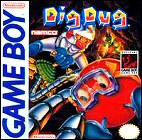
 The Game: You are Dig Dug, an intrepid gardener whose soil is infested with pesky Pookas and fire-breathing Fygars. You’re armed with your trusty pump, which you can use to inflate your enemies until, finally, they blow up. But both the Pookas and Fygars can crawl through the ground and can pop out into your tunnels, and if a Fygar sneaks up behind you, he can toast you if you’re not careful. In New Dig Dug, you guide Dig on a series of subterranean adventures, trying to unlock buried doors by finding some equally buried keys. Pookas and Fygars still stalk the underground tunnels in the new game, only each one that Dig dispatches is replaced by a new Pooka or Fygar from above. (Namco, 1992)
The Game: You are Dig Dug, an intrepid gardener whose soil is infested with pesky Pookas and fire-breathing Fygars. You’re armed with your trusty pump, which you can use to inflate your enemies until, finally, they blow up. But both the Pookas and Fygars can crawl through the ground and can pop out into your tunnels, and if a Fygar sneaks up behind you, he can toast you if you’re not careful. In New Dig Dug, you guide Dig on a series of subterranean adventures, trying to unlock buried doors by finding some equally buried keys. Pookas and Fygars still stalk the underground tunnels in the new game, only each one that Dig dispatches is replaced by a new Pooka or Fygar from above. (Namco, 1992)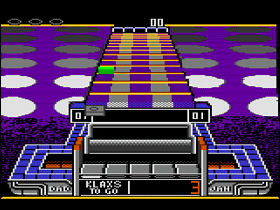 The Game: It is the nineties, as the intro screen says, and there is time for this home version of Klax, in which players try to stack colored bricks according to on-screen instructions: horizontal, vertical and diagonal rows may be required. The conveyor belts carrying the bricks gradually speed up until the bricks are zipping toward the bottom of the screen at a dizzying pace. Allowing too many bricks to slide off the bottom of the screen without catching them will forfeit the game, as will failing to come up with the configuration of stacked bricks demanded by the on-screen instructions. (Atari, 1990)
The Game: It is the nineties, as the intro screen says, and there is time for this home version of Klax, in which players try to stack colored bricks according to on-screen instructions: horizontal, vertical and diagonal rows may be required. The conveyor belts carrying the bricks gradually speed up until the bricks are zipping toward the bottom of the screen at a dizzying pace. Allowing too many bricks to slide off the bottom of the screen without catching them will forfeit the game, as will failing to come up with the configuration of stacked bricks demanded by the on-screen instructions. (Atari, 1990) The Game: Q*Bert, a nosey little guy with a propensity for hopping, spends his time hopping around a three-dimensional pyramid of cubes, avoiding Coily the Snake and other assorted purple and red creatures, including a few who operate on a slightly different plane (i.e., they move down the pyramid as if it were rotated one-third). Changing the colors of the top of every cube in the pyramid to the target color indicated at the top left of the screen will clear the pyramid and start the craziness all over again. If Q*Bert is hit by an enemy or falls off the pyramid, he hits bottom with a resounding, arcade- cabinet-shaking splat and a burst of incomprehensible obscenity! (NTVIC, 1992)
The Game: Q*Bert, a nosey little guy with a propensity for hopping, spends his time hopping around a three-dimensional pyramid of cubes, avoiding Coily the Snake and other assorted purple and red creatures, including a few who operate on a slightly different plane (i.e., they move down the pyramid as if it were rotated one-third). Changing the colors of the top of every cube in the pyramid to the target color indicated at the top left of the screen will clear the pyramid and start the craziness all over again. If Q*Bert is hit by an enemy or falls off the pyramid, he hits bottom with a resounding, arcade- cabinet-shaking splat and a burst of incomprehensible obscenity! (NTVIC, 1992) The Game: Players assume the role of Susumu Kodai, a hot-headed young recruit unexpectedly thrust into a leadership role on a mission to cross the galaxy and procure a device that can restore planet Earth’s war-decimated ecosphere within a year. As if crossing the Milky Way and returning within a year wasn’t enough of a formidable task, the Space Battleship Yamato faces stiff opposition from an alien race, the Gamilas, determined to seal Earth’s fate by bringing the last-ditch rescue mission to a halt. Kodai and the Yamato’s ailing commander, Admiral Okita, must decide where to commit their forces for maximum effect. Large squarons of Cosmo Fighters can be dispatched to take the Gamilas on head-to-head on the on-screen grid, but Yamato herself can also be ordered into the thick of the action (a strategy that puts the entire mission in jeopardy if the battle is lost). Success means fighting through the Gamilas’ offensive front and reaching planet Iskandar. Failure means death for all humankind. Pick your battles wisely. (Interbec, 1992)
The Game: Players assume the role of Susumu Kodai, a hot-headed young recruit unexpectedly thrust into a leadership role on a mission to cross the galaxy and procure a device that can restore planet Earth’s war-decimated ecosphere within a year. As if crossing the Milky Way and returning within a year wasn’t enough of a formidable task, the Space Battleship Yamato faces stiff opposition from an alien race, the Gamilas, determined to seal Earth’s fate by bringing the last-ditch rescue mission to a halt. Kodai and the Yamato’s ailing commander, Admiral Okita, must decide where to commit their forces for maximum effect. Large squarons of Cosmo Fighters can be dispatched to take the Gamilas on head-to-head on the on-screen grid, but Yamato herself can also be ordered into the thick of the action (a strategy that puts the entire mission in jeopardy if the battle is lost). Success means fighting through the Gamilas’ offensive front and reaching planet Iskandar. Failure means death for all humankind. Pick your battles wisely. (Interbec, 1992)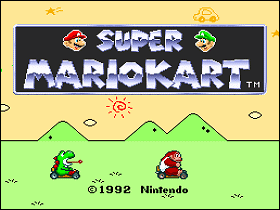 The Game: It’s a big day at the races, with a field of drivers selected from the Mushroom Kingdom: Mario, Luigi, Princess Peach, Toad, Bowser, and even Donkey Kong Jr. are among the racers vying for the top spot. From the grassy Mushroom course to the punishingly muddy Star course to the oceanside Flower course, there are challenges, hairpin turns and obstacles. Whoever can learn to navigate each course the fastest without ending up out of bounds struggling to get back on the course will be the winner. (Nintendo, 1992)
The Game: It’s a big day at the races, with a field of drivers selected from the Mushroom Kingdom: Mario, Luigi, Princess Peach, Toad, Bowser, and even Donkey Kong Jr. are among the racers vying for the top spot. From the grassy Mushroom course to the punishingly muddy Star course to the oceanside Flower course, there are challenges, hairpin turns and obstacles. Whoever can learn to navigate each course the fastest without ending up out of bounds struggling to get back on the course will be the winner. (Nintendo, 1992)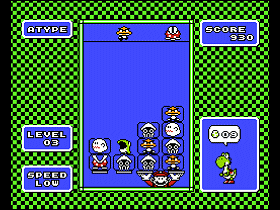 The Game: Mario has to keep more plates spinning than usual. With a plate in each hand, Mario must be moved underneath a never-ending onslaught of enemy creatures. The object of the game is to stack up identical creatures to eliminate them from play, and, when possible, to stack up the two halves of Yoshi eggs to allow a new Yoshi to hatch. Management of the creature stacks is vital, since a stack exceeding the height of the play area ends the game. In two-player mode, both players simultaneously try to outdo the other. (Nintendo, 1992)
The Game: Mario has to keep more plates spinning than usual. With a plate in each hand, Mario must be moved underneath a never-ending onslaught of enemy creatures. The object of the game is to stack up identical creatures to eliminate them from play, and, when possible, to stack up the two halves of Yoshi eggs to allow a new Yoshi to hatch. Management of the creature stacks is vital, since a stack exceeding the height of the play area ends the game. In two-player mode, both players simultaneously try to outdo the other. (Nintendo, 1992) The Game: Captain Picard puts you in charge of a simulated mission aboard the Enterprise. With the helpful advice of Commander Riker, Data, Geordi, Worf and Chief O’Brien, you have to command the pride of the Federation fleet into a number of difficult situations, accomplish as much of the mission objectives as you can, and bring the Enterprise home in one piece. (Absolute, 1993)
The Game: Captain Picard puts you in charge of a simulated mission aboard the Enterprise. With the helpful advice of Commander Riker, Data, Geordi, Worf and Chief O’Brien, you have to command the pride of the Federation fleet into a number of difficult situations, accomplish as much of the mission objectives as you can, and bring the Enterprise home in one piece. (Absolute, 1993)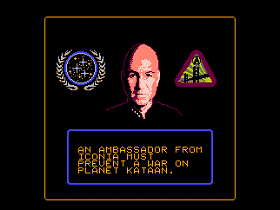 is that?) and having to go to their screens to kick in things like the shields, weapons and warp drive, when it comes right down to it, if you strip away these elements, it’s the same basic game: you’re blasting away at enemy ships and hoping to get more clean shots in at them then they get at you. He whose shields fail first gets blown out of the sky. In 11 years, the basic Star Trek game hadn’t evolved that much (but at least The Next Generation doesn’t get the torturously slow “story” scenes of Star Trek: 25th Anniversary).
is that?) and having to go to their screens to kick in things like the shields, weapons and warp drive, when it comes right down to it, if you strip away these elements, it’s the same basic game: you’re blasting away at enemy ships and hoping to get more clean shots in at them then they get at you. He whose shields fail first gets blown out of the sky. In 11 years, the basic Star Trek game hadn’t evolved that much (but at least The Next Generation doesn’t get the torturously slow “story” scenes of Star Trek: 25th Anniversary). 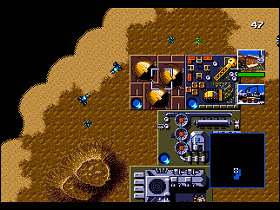 The Game: Three Houses – Atreides, Harkonnen and Ordos – converge on the planet Dune, intending to consolidate their power and eliminate one another from the business of mining the spice melange from the planet’s sandy surface. Players pick a House and then take command of both the mining and military efforts, directing and managing each, and facing stiff opposition from the other Houses. As long as spice is being extracted from Dune, the player can summon or build whatever resources are needed to continue the mission and crush the opposing forces. The only path to victory is the destruction of the other Houses and complete control of the planet. (1993, Westwood Studios / Virgin Interactive)
The Game: Three Houses – Atreides, Harkonnen and Ordos – converge on the planet Dune, intending to consolidate their power and eliminate one another from the business of mining the spice melange from the planet’s sandy surface. Players pick a House and then take command of both the mining and military efforts, directing and managing each, and facing stiff opposition from the other Houses. As long as spice is being extracted from Dune, the player can summon or build whatever resources are needed to continue the mission and crush the opposing forces. The only path to victory is the destruction of the other Houses and complete control of the planet. (1993, Westwood Studios / Virgin Interactive) The Game: As a round yellow creature consisting of a mouth and nothing else, you maneuver around a relatively simple maze, gobbling small dots and evading colorful monsters who can eat you on contact. Large red dots enable you to turn the tables and eat the monsters for a brief period. Periodically, assorted items appear in the maze, and you can consume these for additional points and power-ups. (Semicom, 1995)
The Game: As a round yellow creature consisting of a mouth and nothing else, you maneuver around a relatively simple maze, gobbling small dots and evading colorful monsters who can eat you on contact. Large red dots enable you to turn the tables and eat the monsters for a brief period. Periodically, assorted items appear in the maze, and you can consume these for additional points and power-ups. (Semicom, 1995)
 The Game: An alien war fleet is closing in on Earth, armed with a powerful weapon that can eradicate the entire planet. You (and, if you happen to have some fellow gunners, four others) man the artillery batteries of an armed-to-the-teeth ship on a mission to take the fight to the aliens before they can bring it to Earth. If you successfully complete that mission, you can also move on to a second mission to defend the planet Gourb from the Galaxian fleet. (Namco, 1995)
The Game: An alien war fleet is closing in on Earth, armed with a powerful weapon that can eradicate the entire planet. You (and, if you happen to have some fellow gunners, four others) man the artillery batteries of an armed-to-the-teeth ship on a mission to take the fight to the aliens before they can bring it to Earth. If you successfully complete that mission, you can also move on to a second mission to defend the planet Gourb from the Galaxian fleet. (Namco, 1995)
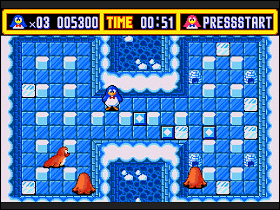 The Game: Pengo the penguin is trapped in an ice maze with seals, walking snowmen and other predators. Pengo can defeat his enemies by pushing ice blocks toward them, crushing them in the process. Pengo can also create new ice blocks via some biological process that’s perhaps best left unexplored (and if he doesn’t leave the spot where he generates ice blocks immediately after starting that process, he’ll be temporarily frozen to that spot); those blocks can also become ammo in a pinch. Treats such as dollar signs and popsicles – both valuable commidities to penguins – appear from time to time. Defeating all enemies on a given level advances Pengo to the next screen. (Sega, 1995, for Japanese market only)
The Game: Pengo the penguin is trapped in an ice maze with seals, walking snowmen and other predators. Pengo can defeat his enemies by pushing ice blocks toward them, crushing them in the process. Pengo can also create new ice blocks via some biological process that’s perhaps best left unexplored (and if he doesn’t leave the spot where he generates ice blocks immediately after starting that process, he’ll be temporarily frozen to that spot); those blocks can also become ammo in a pinch. Treats such as dollar signs and popsicles – both valuable commidities to penguins – appear from time to time. Defeating all enemies on a given level advances Pengo to the next screen. (Sega, 1995, for Japanese market only)
 The Game: Three of the most popular games from Namco’s arcade heyday are brought back in the ’90s, both in their original forms and in “remixed” versions with updated sound and graphics and tweaks to the game play. Pac-Man Arrangement adds power-ups, new mazes, new graphics and a whole new breed of monsters to the most classic arcade game of the 80s, while Rally-X Arrangement refuels with power-ups and audiovisual enhancements of its own. Dig Dug Arrangement revamps the underground classic with a new breed of enemies – and a new variety of ways to eliminate them. (Namco, 1996)
The Game: Three of the most popular games from Namco’s arcade heyday are brought back in the ’90s, both in their original forms and in “remixed” versions with updated sound and graphics and tweaks to the game play. Pac-Man Arrangement adds power-ups, new mazes, new graphics and a whole new breed of monsters to the most classic arcade game of the 80s, while Rally-X Arrangement refuels with power-ups and audiovisual enhancements of its own. Dig Dug Arrangement revamps the underground classic with a new breed of enemies – and a new variety of ways to eliminate them. (Namco, 1996)